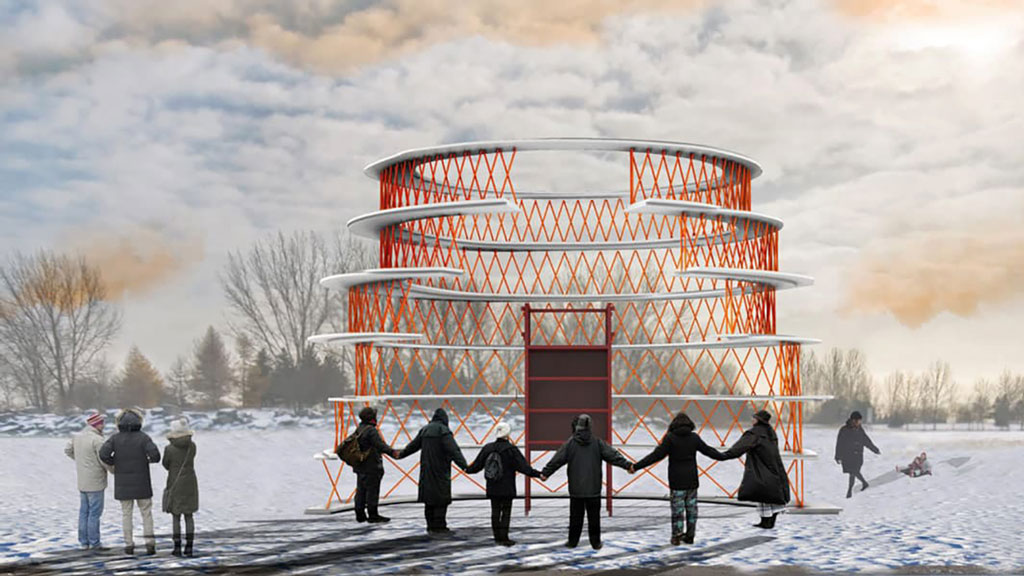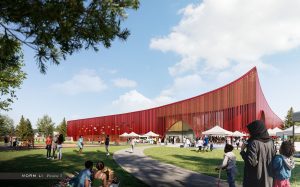TORONTO — The winning designs of the 2022 Winter Stations international competition illustrate the theme of resilience and the ability to withstand adversity and recover from difficulties.
Held annually in Toronto, participants are tasked with designing temporary winter art installations that incorporate existing lifeguard towers across the city’s Kew and Woodbine beaches which are not in use in the winter.
The public exhibition will take place at Woodbine Beach in Toronto Feb. 21 to March 31. The competition is designed to draw people to the beach in the wintertime.
The designs of the 2022 edition include:
Enter Face by MELT — Cemre Onerturk and Ege Cakır (Turkey)
The pandemic has shifted our communication with people, interaction with the environment and the perception of our experiences to the digital screen. This project aims to show the impact of the screens. It proposes two dark boxes with distant holes for people to get their upper bodies inside and stay detached from one another. Within the boxes, a textured transparent surface is placed through which the distant visitors, who become a group of viewers now, watch life outside the box as if they are spectating a neverending moving image on a screen together.
Wildlife-guard Chair by Mickael Minghetti, with the guidance of Andres Jimenez Monge (France and Canada)
Inspired by the northern cardinal bird, a species present all-year-round in Ashbridge’s Bay Park, the station seeks to engage the visitors with Toronto’s wildlife.
The Hive by Kathleen Dogantzis and Will Cuthbert (Canada)
The resilience witnessed among communities in the face of challenging and unprecedented times is paralleled with honey bee colonies, which are primarily composed of worker bees whose greatest measure of resilience is maintaining hive temperature throughout the cold winter months. The installation is designed with a hexagonal structure reminiscent of a honey bee colony and it highlights the colour variation of honey, which is the result of diverse floral resources.

S’winter Station by Ryerson University’s Department of Architectural Science (Canada)
The forces of nature are relentless. Like the falling snow of the sky and the shifting sands of the beach, the pavilion embraces local wind, snow and sun conditions. Following these directions of force, the pavilion’s wings embody movement by harnessing snow and mitigating strong winds. Beach towels have been formed into dynamic concrete panels with varying openings which control the amount of light and snow allowed to enter, while also creating unique views outwards.
Introspection by University of Toronto John H. Daniels Faculty of Architecture, Landscape and Design (Canada)
This design is based on the emotions felt throughout the past two years’ worth of quarantine and isolation. Playing with the idea of reflection, mirrored walls are used to cast the visitors as the subjects of the bright red pavilion. While the trellis roof allows the sun to illuminate the interior and its visitors, the red lifeguard tower stands unyielding in the centre of the pavilion, reminding us of the inherent stability within us.
One Canada by University of Guelph, School of Environmental Design and Rural Development (Canada)
Indigenous people in Canada are an example of resilience due to their ability to withstand adversity and persevere through generations of oppressive colonial policies. Historic injustices persist, including the effects of cultural genocide from the residential school system of Canada.
This station symbolizes bridging the gap between Indigenous and non-Indigenous people through gathering.
Accomplished through the support of the seven grandfather teachings, represented by the seven rings of the installation which originated with the Anishnabae Peoples, passed down through generations. Orange represents the National Day of Truth and Reconciliation.











Recent Comments
comments for this post are closed